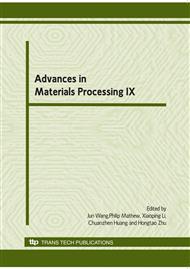p.116
p.122
p.128
p.134
p.140
p.146
p.152
p.158
p.164
Application of Back-Up Ring in Fine-Blanking Process
Abstract:
Considering the advantages of the fine-blanking process, the smooth-cut surface without further operation could be fabricated. However, one of the major problems of the fine-blanking is the occurrence of the die-roll formation. This problem is the main factor which affects the quality of the fine-blanked parts. In this study, to reduce the amount of die-roll formation, the application of back-up ring was proposed. The finite element method (FEM) was used to investigate the effects of back-up ring. In addition, the effects of bridge width were also investigated. The FEM simulation results illustrated that the mechanism of back-up ring and the effects of bridge width could be theoretically clarified base on the material flow analysis. The FEM simulation and experimental results showed the good agreement with each other. Therefore, the application of back-up ring could reduce the amount of die-roll formation on the fine-blanked parts. In this study, the amount of die-roll formation increased as the bridge width increase and it was constant at the bridge width of over 15 mm.
Info:
Periodical:
Pages:
140-145
Citation:
Online since:
June 2010
Authors:
Keywords:
Price:
Сopyright:
© 2010 Trans Tech Publications Ltd. All Rights Reserved
Share:
Citation:


